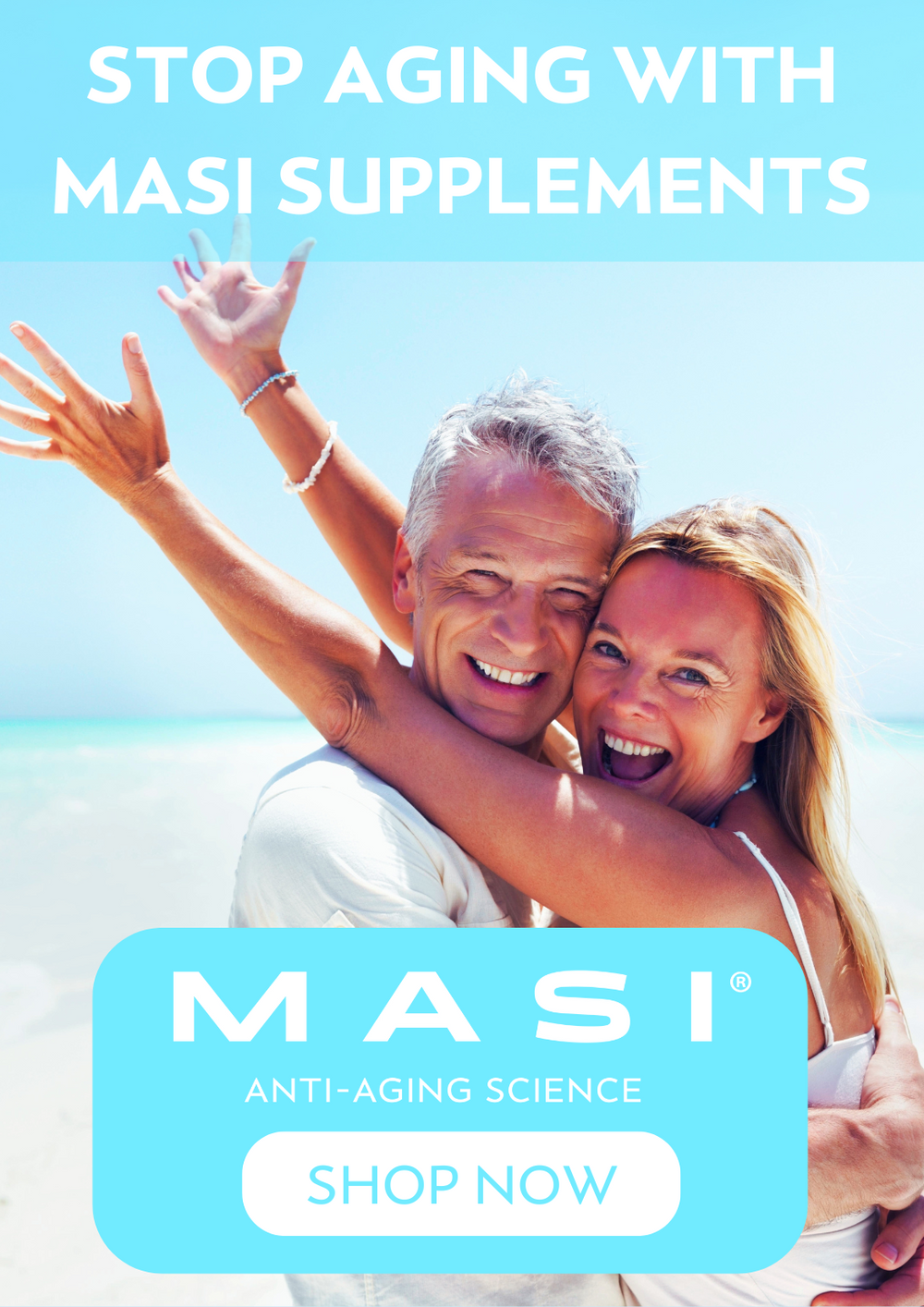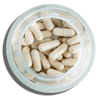Not all omega-3 supplements are created equal. Many contain harmful contaminants or fail to deliver the promised health benefits. Here's how you can ensure your omega-3 supplement is pure and effective:
- Check EPA & DHA Levels: Look at the Supplement Facts panel. High-quality supplements should have concentrated EPA and DHA (up to 90%). Most adults need 500-1,000 mg daily.
- Look for Triglyceride Form: Triglycerides are absorbed up to 71% better than ethyl esters. If the label doesn’t specify, it’s likely the less effective ethyl ester form.
- Verify Certifications: Choose products with certifications like IFOS, GOED, or USP to ensure purity, potency, and safety.
- Sourcing Matters: Opt for supplements from sustainably sourced fish or krill, verified by certifications such as MSC or Friend of the Sea.
- Test for Freshness: Break open a capsule. A strong fishy smell or sour taste indicates rancidity.
- Request a COA: Ask the manufacturer for a Certificate of Analysis for detailed quality testing results.
The Wellness Podcast Ep6: Fish Oil Purity and What To Look Out For
Key Factors in Evaluating Omega-3 Supplement Purity
Choosing the right omega-3 supplement can feel overwhelming, but focusing on three key factors can simplify the process. These factors directly influence how effectively your body absorbs and uses the omega-3s you’re investing in.
Understanding EPA and DHA Concentrations
When evaluating omega-3 supplements, the most important details aren’t on the front label - they’re in the Supplement Facts panel. EPA (eicosapentaenoic acid) and DHA (docosahexaenoic acid) are the active components that provide the health benefits of omega-3s. Their concentrations determine a supplement’s potency and purity.
"For omega-3-rich fish and their oils, the active ingredients we're concerned about for potency purposes are the marine omega-3s EPA and DHA", explains Ashley Jordan Ferira, Ph.D., RDN, mbg's director of scientific affairs [3].
Here’s an important note: natural fish oil contains about 30% EPA and DHA. This means that a typical 1,000 mg fish oil capsule might only deliver around 300 mg of actual omega-3s. However, high-quality supplements concentrate these oils, offering up to 90% EPA and DHA [1]. This ensures you’re getting more of the beneficial components and less filler.
Dr. Ferira suggests a simple way to assess any omega-3 supplement: "Turn over your bottle and look for these line items [EPA and DHA] in the Supplement Facts panel and add them up" [3]. The total indicates the actual omega-3 content per serving.
Most adults need at least 500 mg of EPA and DHA daily [3], though many experts recommend 1,000 mg or more for cardiovascular health. Unfortunately, a 2015 study found that 30% of omega-3 supplements failed to deliver the EPA and DHA amounts listed on their labels [1]. This highlights the importance of careful label scrutiny.
Once potency is verified, the next step is understanding the molecular form of the omega-3s.
Molecular Forms: Triglycerides vs. Ethyl Esters
The molecular form of omega-3s - either triglyceride or ethyl ester - determines how well your body absorbs them. This distinction can significantly impact the supplement’s effectiveness.
Triglycerides are the natural form of omega-3s found in fish [2]. When you eat fish like salmon or sardines, you’re consuming omega-3s in triglyceride form. Ethyl esters, on the other hand, are created in a lab through a chemical process called trans-esterification [2]. While both forms provide EPA and DHA, your body processes them very differently.
Research shows that omega-3s in triglyceride form are absorbed up to 71% more efficiently than those in ethyl ester form [2]. Ethyl ester fish oil is processed 10 to 50 times less efficiently, meaning you might not be reaping the full benefits of what seems like a high-potency supplement.
"Triglyceride fish oil, being in its natural form, has much higher bioavailability than omega-3 ethyl esters", [2] making it the preferred choice for optimal absorption.
Another critical factor is stability. Ethyl ester fish oil is more prone to oxidation, which means it can go rancid faster [2]. Oxidized omega-3s can undermine your health goals, making stability a key consideration for long-term effectiveness.
It’s worth noting that only a few manufacturers re-convert ethyl ester omega-3s back into triglyceride form because the process is both costly and time-consuming [2]. As a result, many supplements stick with the cheaper but less effective ethyl ester form. To check your supplement, look for the word “triglyceride” on the label - if it’s not specified, it’s likely ethyl ester [2].
With potency and form confirmed, the final step is examining sourcing and certifications for quality assurance.
Sourcing and Environmental Certifications
Purity starts with responsibly sourced fish. The origin of the fish, the sustainability of the fishing practices, and adherence to environmental standards all play a role in the quality and safety of omega-3 supplements.
Certifications like Marine Stewardship Council (MSC) and Friend of the Sea signal sustainable fishing practices [5][6]. But they also indicate a higher commitment to quality. Companies that pursue these certifications often maintain rigorous standards throughout their supply chain.
For instance, in 2017, Sam’s Club made a notable commitment to sustainability. Under Jill Turner-Mitcheal’s leadership as Senior Vice President of Consumables and Health & Wellness, 100% of their private label Member’s Mark fish and krill oil supplements became traceable to MSC-certified fisheries [7]. This effort earned the company the US Ocean Champion award from the Marine Stewardship Council.
"At Sam's Club we know our members care about having access to quality products at a great value that are healthy choices for themselves as well as the environment", Turner-Mitcheal shared [7].
Other certifications, such as MarinTrust and ORIVO, ensure that raw materials come from responsible fisheries and verify the authenticity of marine ingredients based on species and geographic origin [5]. These measures help protect against contamination from polluted waters and ensure the fish species listed on the label matches what’s in the bottle.
For those concerned about overfishing, the numbers around krill harvesting are reassuring. The Antarctic Ocean’s krill biomass is estimated between 125 million and 750 million tons [6]. In approved harvesting areas, the biomass exceeds 60 million tons, with a quota allowing only 9% of that amount [6]. Even Aker Biomarine, the largest krill harvester, uses just 1/3 of 1% of the allowable quota [6].
Certifications like IFOS (International Fish Oil Standards) and IKOS (International Krill Oil Standards) go even further, testing for contaminants such as heavy metals and PCBs [5]. This ensures your supplement is not only effective but also safe.
As the Global Organization for EPA and DHA Omega-3s (GOED) puts it: "Maintaining our oceans is not only good environmental stewardship, but also ensures sustainable growth for the omega-3 industry as a whole" [6]. By choosing certified products, you’re supporting your health while contributing to the long-term availability of clean omega-3 sources.
Third-Party Testing and Certification Standards
When it comes to omega-3 supplements, third-party testing plays a crucial role in verifying product claims and ensuring safety. These certifications act as a safeguard, confirming that the contents match the label and that harmful contaminants are absent.
Independent certifications not only guarantee consistent quality but also build trust among consumers. As Nutrasource explains:
"Our passion for scientific evidence and commitment to supporting accurate label claims provides our clients with a validated, research-backed way to confirm their products are safe, pure, and properly labelled" [8].
This level of validation sets premium brands apart, demonstrating their dedication to rigorous testing and transparency.
These tests ensure that supplements meet label claims, remain free of contaminants, dissolve as they should, and comply with current Good Manufacturing Practices (cGMPs). Without such standards, consumers are left relying solely on manufacturers' claims - a risky gamble when it comes to health. Third-party testing also reinforces critical factors like EPA/DHA concentration and sourcing integrity.
Let’s dive into how certifications from IFOS, GOED, and USP help validate supplement purity.
IFOS Certification Standards
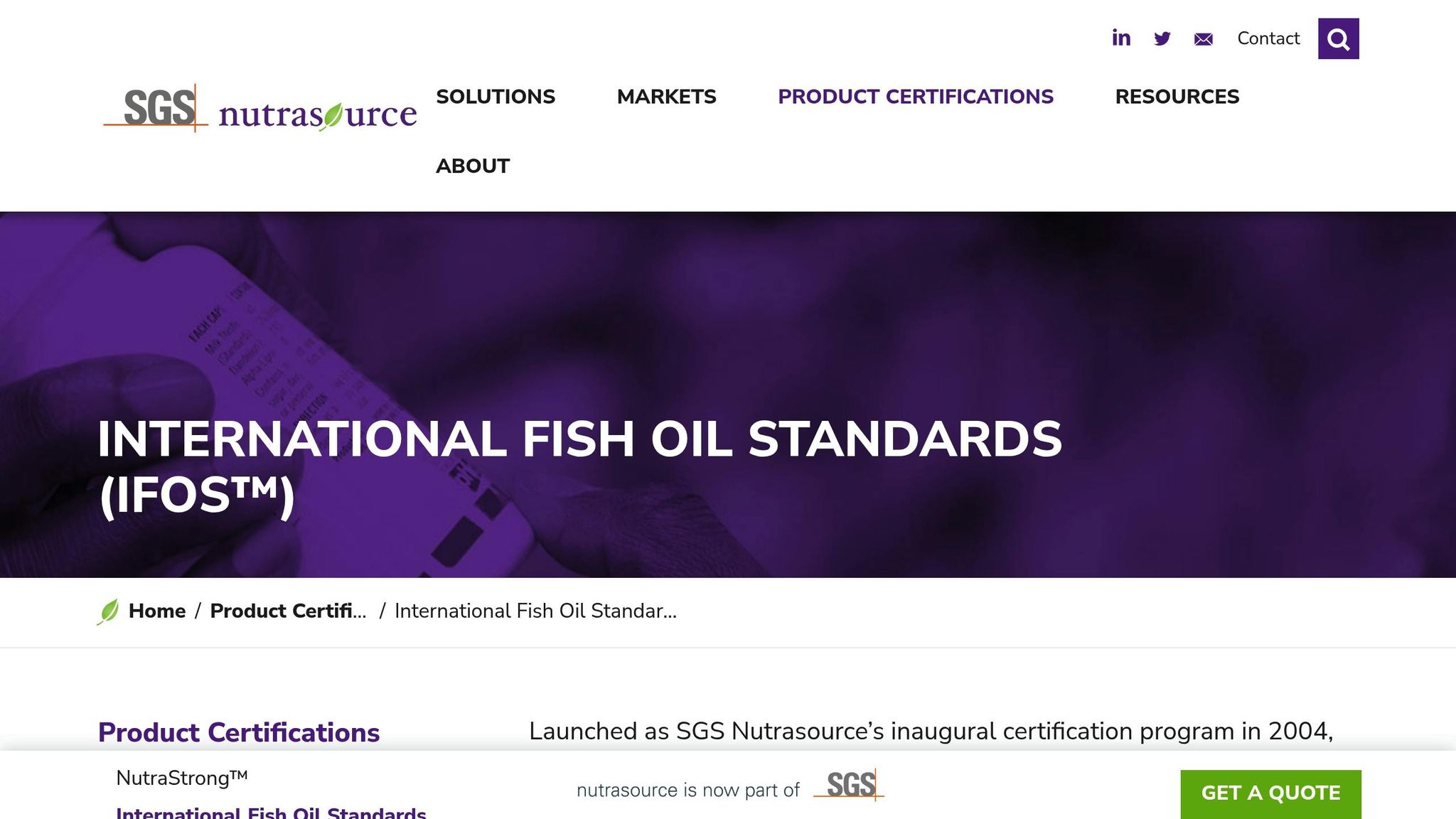
The International Fish Oil Standards (IFOS) program is widely regarded as the benchmark for omega-3 certification. Using a 5-star rating system, IFOS evaluates products on key factors like oxidation levels and label accuracy.
To date, IFOS has certified over 200 brands globally and tested more than 15,000 products. Their testing examines peroxide values, anisidine values, and TOTOX scores to determine freshness and ensure the absence of harmful contaminants. These oxidation markers are essential for identifying whether omega-3 oils are fresh or rancid.
What sets IFOS apart is its transparency. Test results for certified products are published online, giving consumers easy access to detailed reports. For instance, OMAPURE Omega-3 supplements have undergone IFOS testing and received the highest 5-star rating [4]. This rating signifies that the product exceeds industry standards across all tested categories, making it simple for consumers to identify top-quality options.
GOED Monographs and Freshness Benchmarks
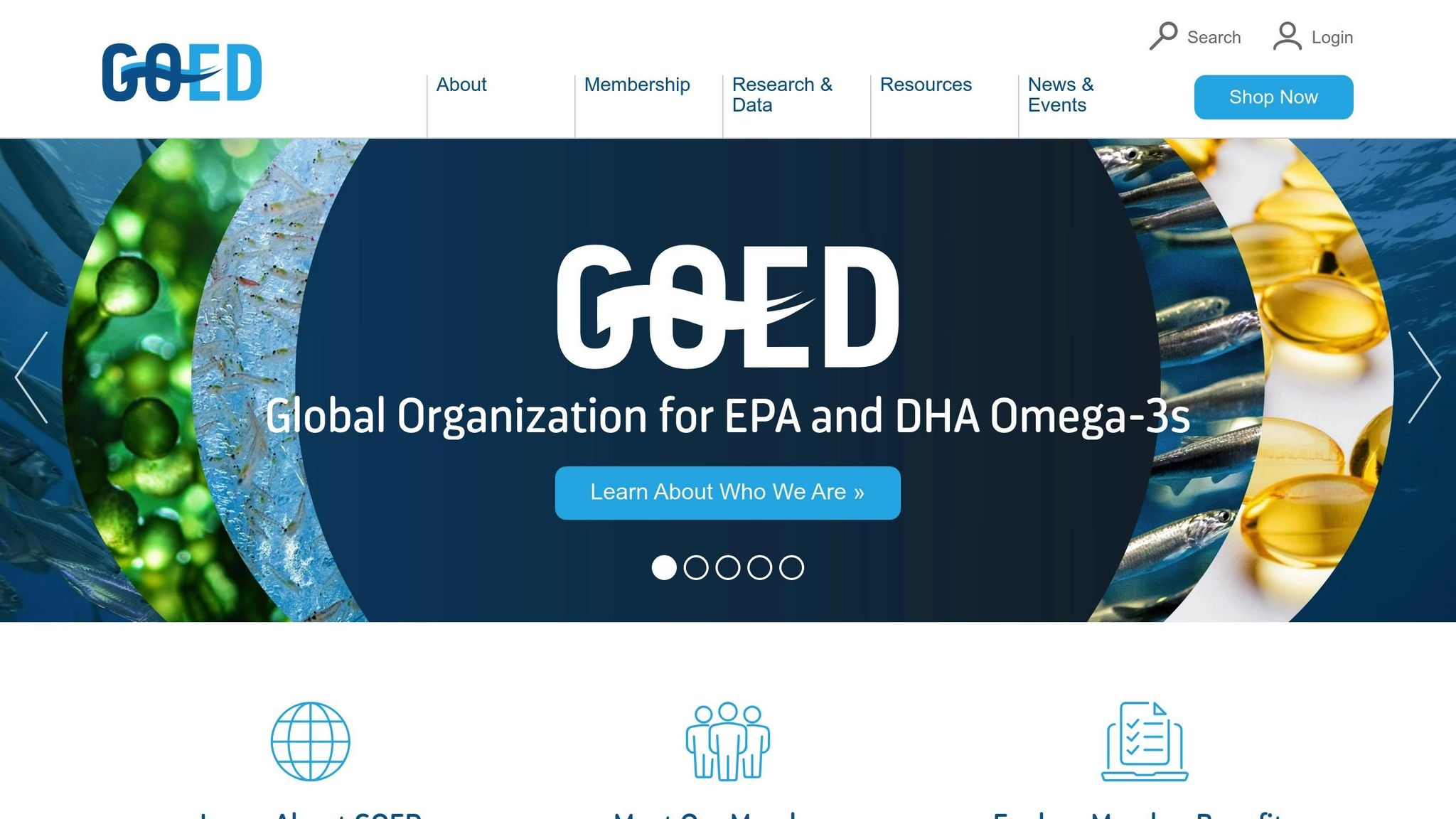
The Global Organization for EPA and DHA Omega-3s (GOED) provides another layer of quality assurance with its Voluntary Monograph, which has guided the omega-3 industry since 2002 [12]. This framework focuses on oxidative quality, environmental contaminants, and the measurement of EPA and DHA.
Freshness is a key concern, as oxidized omega-3s may not deliver their intended health benefits. GOED sets specific limits for peroxide values, para-anisidine values (p-AV), and TOTOX scores - metrics that indicate oil freshness.
Recent testing by GOED revealed promising results. An analysis of 48 widely sold U.S. omega-3 supplements found that all contained at least 80% of the EPA and DHA levels claimed on their labels [13]. Additionally, nearly 60% exceeded their label claims [13]. Over 85% of products met peroxide limits, while 96% of unflavored oils complied with p-AV standards, averaging a low level of 9.0 (well below the limit of 20) [13]. TOTOX scores showed that 87% of unflavored oils were within acceptable limits, with an average score of 19.2 compared to a maximum limit of 26 [13].
Ellen Schutt, executive director of GOED, highlighted the findings:
"While room for improvement exists, the results show that a significant portion of products available to American consumers comply with regulatory requirements in the US or are of good quality" [13].
One standout product from the analysis was Wiley's Finest Peak EPA, which contained 95.3% of the EPA + DHA claimed on the label and recorded the lowest p-AV and TOTOX levels - 1.9 and 7.5, respectively [13].
United States Pharmacopeia (USP) Verification
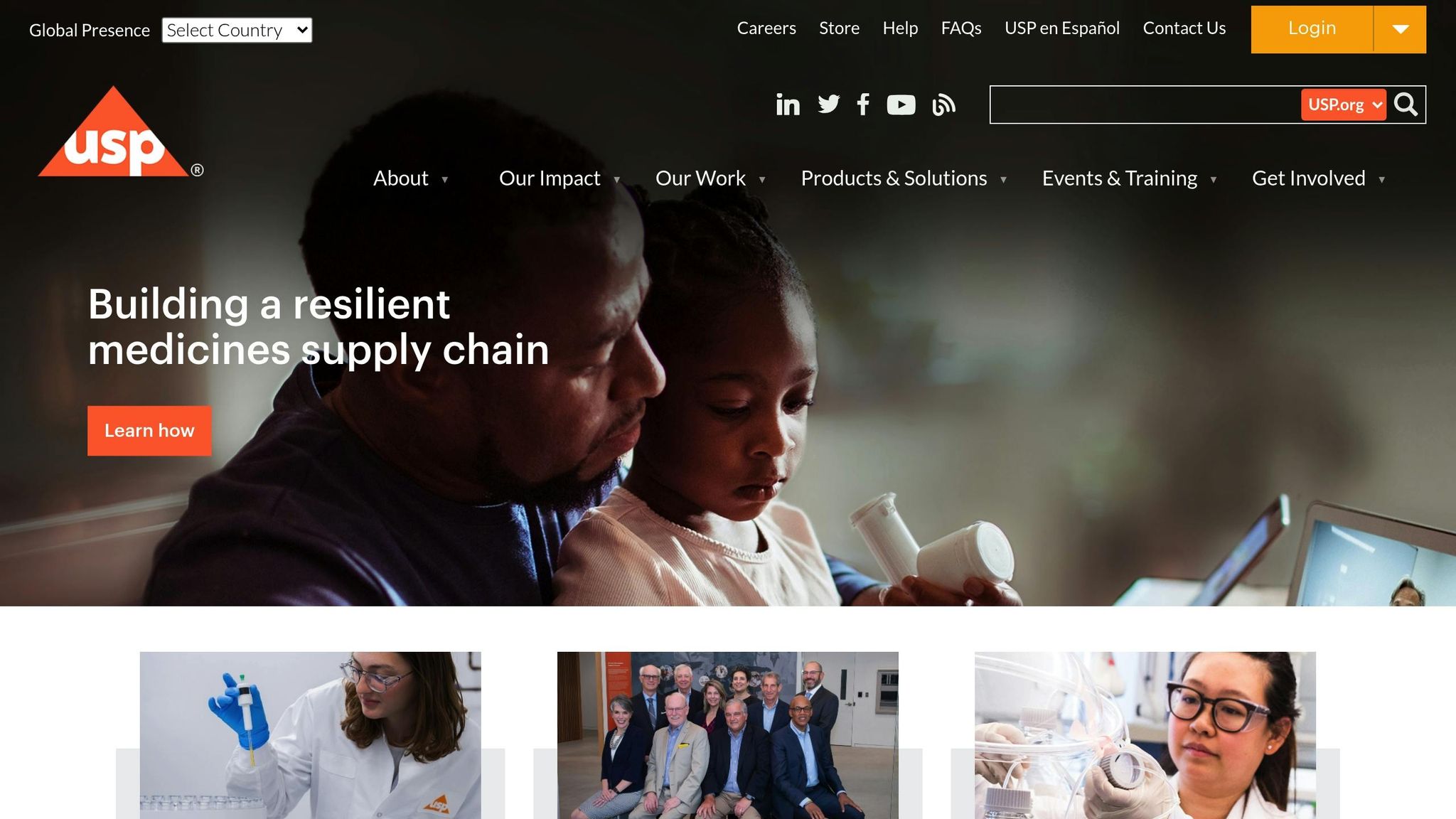
The United States Pharmacopeia (USP) verification offers yet another layer of assurance. This certification confirms that supplements deliver the stated potency, are free from harmful contaminants, and are manufactured according to FDA cGMP standards [9].
The USP Verified Mark appears on over 700 million supplement labels [9], reflecting its credibility and the trust consumers place in independent testing.
USP testing includes several key areas:
- Identity testing: Ensures ingredients match the label.
- Potency testing: Verifies the concentration of active ingredients.
- Purity testing: Screens for contaminants.
- Dissolution testing: Confirms proper breakdown in the digestive system.
For example, Trident Seafoods offers two USP-verified products: the Pure Alaska Omega Wild Alaskan Salmon Oil 1,000 mg Softgel and the Kirkland Signature Wild Alaskan Fish Oil 1,400 mg Softgel [10]. Similarly, Nature Made Omega-3 products carry the USP Verified Mark [11]. This is particularly important given that over two-thirds (68%) of U.S. adults fall short of the recommended EPA and DHA intake based on the U.S. Dietary Guidelines for Americans [11].
The USP Verified Mark serves as a trusted guide in the crowded supplement market, assuring consumers that a product has undergone rigorous testing and meets established standards for quality, purity, and potency.
Simple Methods to Assess Freshness and Purity
Checking the freshness and purity of your omega-3 supplements doesn't have to be complicated. While third-party certifications provide a trustworthy seal of quality, there are a few easy at-home methods you can use to evaluate your supplement. These quick tests can help you spot signs of oxidation or rancidity that might not be obvious from the packaging. Think of them as an extra layer of assurance to complement the certifications.
Capsule Smell and Taste Tests
Your nose and taste buds are surprisingly good at detecting spoilage in fish oil supplements. Fresh, high-quality omega-3s should have a mild, ocean-like scent - not an overpowering fishy smell.
To test this, break open a soft gel capsule and take a sniff. If you notice a strong, unpleasant fishy odor, the oil has likely oxidized [14]. Similarly, taste the oil (without swallowing). A sour, fishy, or generally unpleasant flavor is another red flag. OmegaQuant puts it best:
"If the smell isn't swell, well, that's a tell, that the fish oil's not necessarily well" [14].
Additionally, if the supplement tastes bad, causes gagging, or leads to excessive burping, it’s probably time to stop using it [14]. Be cautious with flavored products, as they can hide signs of rancidity. Unflavored options are better for these types of tests [15].
Visual Oil Clarity
If the smell or taste raises concerns, take a closer look at the oil itself. The color and clarity can reveal a lot about its condition. Good-quality fish oil is usually clear and light-colored. If the oil looks cloudy or yellowish, it might be oxidized.
Ashley Jordan Ferira, Ph.D., RDN, explains:
"Like any oil, rancidity indicates subpar quality control. Practically, this [more oxidized, rancid oil] means a more yellow fish oil and a fishier smell" [3].
When inspecting the oil, unflavored products work best since added colors from flavorings can make it harder to judge its natural appearance.
Requesting Certificates of Analysis (COA)
For a deeper dive into your supplement’s quality, ask for a Certificate of Analysis (COA). This document includes detailed, batch-specific results that verify the product’s purity, potency, and safety. Many manufacturers provide COAs online, and you can usually match them to the lot number on your product bottle [17].
When reviewing a COA, pay attention to key details like:
- Peroxide levels
- Anisidine values [16]
- Heavy metal, PCB, and dioxin levels
- EPA and DHA concentrations
- Microbiological testing results
If you can’t find a COA online, reach out to the manufacturer. A lack of transparency or delays in providing this information could be a warning sign about the supplement’s quality.
sbb-itb-4f17e23
Manufacturer Transparency and Best Practices
When it comes to omega-3 supplements, a manufacturer's transparency can be a key indicator of product quality. Companies that openly share details about their sourcing, manufacturing processes, and testing practices show confidence in their products while prioritizing consumer safety.
Certifications are helpful for verifying a product’s contents, but transparency in production goes a step further by building trust in the overall quality. Research has shown that over 70% of omega-3 supplements tested failed to deliver the amount of EPA and DHA listed on their labels [21]. This highlights the importance of transparency - not just as a nice-to-have feature, but as a crucial factor in protecting your health. Beyond certifications, examining supply chain details and packaging practices can further confirm the quality of a product.
Supply Chain Traceability
Transparency in sourcing plays a vital role in ensuring the purity of omega-3 supplements. To truly understand what you’re buying, you need insight into the entire supply chain. This includes knowing where the ingredients come from, how they’re harvested, and whether sustainable practices are in place. Certifications like Organic, non-GMO, and B Corp can provide additional assurance [20]. Reliable manufacturers ensure their raw material suppliers follow strict GMP standards and undergo regular third-party testing for both raw materials and finished products [20].
For example, Vital Pet Life partnered with Bioriginal in January 2023 to strengthen its supply chain integrity. This collaboration led to the brand earning ORIVO certification, setting it apart from competitors that may unknowingly - or even intentionally - engage in food fraud [19].
Cameron Kupper, Vice President of Business Development at Bioriginal, explains why transparency is becoming more critical:
"Through advances in analytical methodology, it has now become possible to hold supply chains accountable for the quality and sustainability of ingredients. Food fraud is not a new concept, especially in terms of high-value ingredients like fish oils. As pet food consumers become increasingly savvy, the demand for transparency will follow. I expect we will see a further influx of brands prioritizing transparency for the safety of our pets" [19].
When evaluating a supplement manufacturer, check if they provide detailed information about their processes and testing methods. Look for companies that use traceability systems to track every ingredient from its source to the final product [18]. A Certificate of Analysis (COA) from suppliers can also confirm the identity and purity of each ingredient [18].
Packaging and Stability Measures
Proper packaging plays a critical role in maintaining the quality and effectiveness of omega-3 supplements. These fatty acids are prone to oxidation, which can reduce their nutritional value and even produce harmful byproducts [22]. Packaging designed to minimize exposure to light, oxygen, and heat is essential for preserving product quality.
For instance, opaque plastic or dark glass bottles, as well as blister packs, are effective at limiting light exposure [24]. MVS Pharma takes this a step further by using single hard capsule packaging, with each capsule individually protected in a paper box to guard against sunlight and oxidation [23].
Research indicates that capsules are better at maintaining quality compared to syrup forms [22]. Liquid-filled hard capsules, in particular, offer several advantages over traditional softgels. They reduce waste, control moisture better, have lower oxygen permeability, and even allow for vegetarian formulations [23].
Some manufacturers go the extra mile by including antioxidants like vitamin E in their formulations to prevent oxidation during storage [23]. Clear storage instructions - such as keeping supplements in cool, dark places away from heat sources - are also crucial for preserving quality [24].
Studies have revealed significant variations in fish oil quality between products from the same brand but purchased at different stores. These inconsistencies often result from differences in raw materials or processing [22]. This underscores the importance of consistent manufacturing, packaging, and storage practices to ensure supplements retain their potency and purity throughout their shelf life.
When assessing a manufacturer, ask about their packaging methods, storage guidelines, and stability testing. Companies that can clearly explain how they protect their products from degradation are likely to deliver omega-3 supplements that meet high standards of quality and reliability.
MASI Longevity Science: A Commitment to Purity
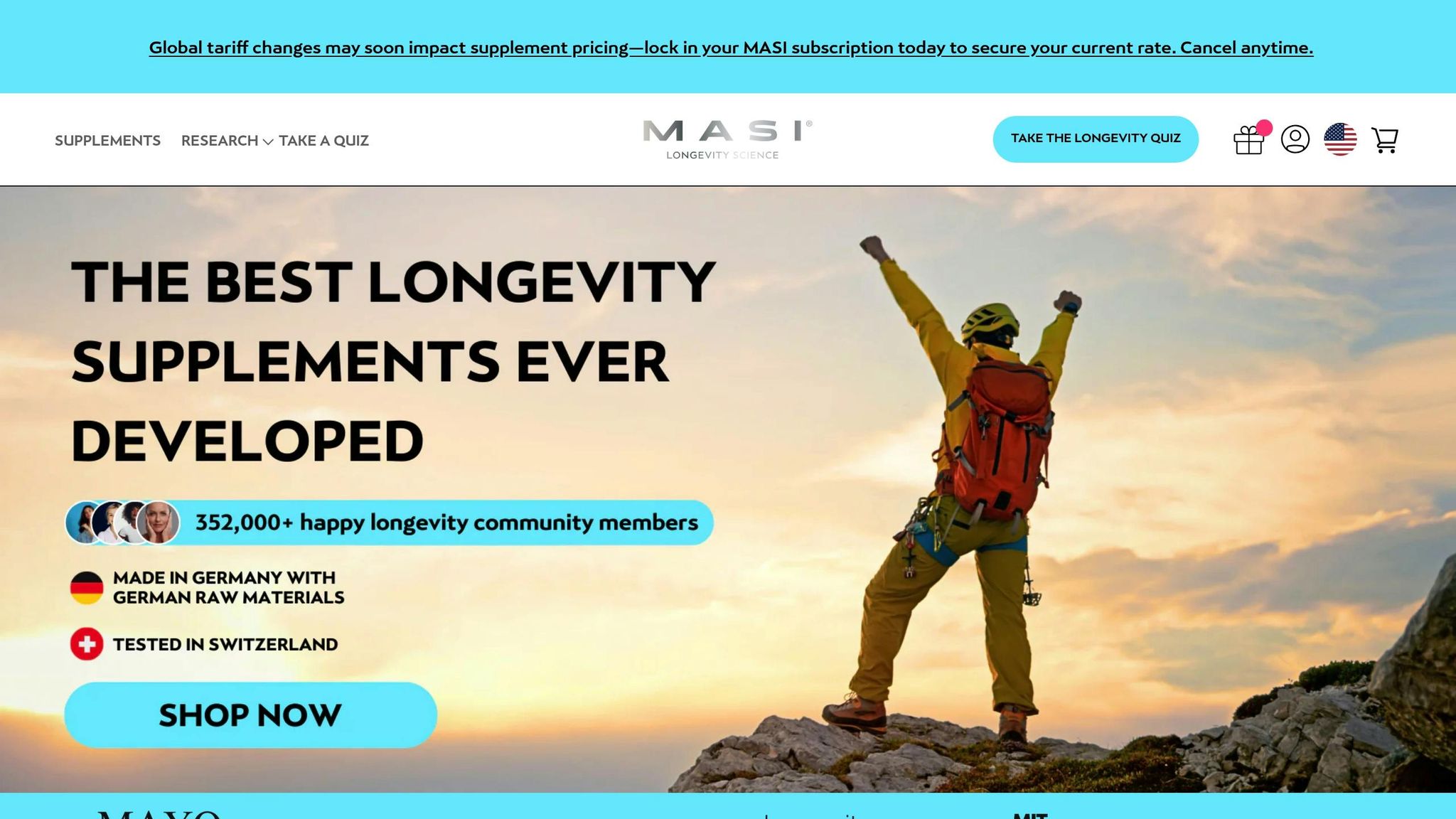
MASI Longevity Science stands as a benchmark for quality and integrity in the supplement industry, a field often challenged by inconsistent standards and limited transparency. By prioritizing purity and effectiveness, MASI has earned a reputation for delivering supplements that meet the highest expectations.
At the core of MASI's approach is pharmaceutical-grade manufacturing. Every supplement is produced in Germany using top-tier raw materials that comply with stringent pharmaceutical standards. This meticulous process ensures that each ingredient is held to the same rigorous criteria used in the production of medicines, far exceeding the typical requirements for dietary supplements.
What truly sets MASI apart is its independent testing protocol. Instead of relying solely on supplier-provided certifications, the company conducts third-party testing in Swiss laboratories. These tests evaluate three critical aspects: purity, safety, and effectiveness. This extra layer of scrutiny ensures that every product delivers on its promises, giving consumers confidence in their health investments.
MASI also emphasizes Batch-Specific Transparency. Every production batch undergoes thorough testing, and the results are documented in a Certificate of Analysis (COA). These COAs verify the product's identity, purity, and compliance with quality standards. By making these documents accessible, MASI allows customers to confirm the purity and potency of the supplements they purchase.
The product lineup - featuring NMN, Resveratrol, Fisetin, and Spermidine - focuses on addressing key factors of aging. These supplements support cellular renewal and promote brain and heart health, all while adhering to MASI's uncompromising purity standards.
MASI's dedication to purity extends to its Allergen-Free Formulations. All products are free from GMOs, soy, lactose, gluten, and common allergens, making them suitable for a wide range of dietary needs. By eliminating unnecessary additives and potential contaminants, MASI ensures that customers receive only the active ingredients their bodies require.
The trust MASI has built is reflected in its global community of over 352,000 members, who rely on these supplements to achieve their longevity and wellness goals. This level of consumer confidence is a direct result of MASI’s consistent delivery of high-quality products that meet - and often exceed - expectations.
For anyone evaluating supplements using the purity standards discussed earlier, MASI Longevity Science exemplifies how transparency, rigorous testing, and pharmaceutical-grade manufacturing can work together to ensure quality and effectiveness. This meticulous approach highlights how such standards can positively impact long-term health outcomes.
Conclusion and Key Takeaways
Choosing a pure and effective omega-3 supplement requires a thoughtful approach that combines careful label scrutiny, independent certifications, freshness checks, and manufacturer transparency. Research highlights that only 70% of omega-3 supplements meet their claimed EPA/DHA levels [1], and 45% show signs of rancidity [15].
Start by examining the label for EPA and DHA content and look for third-party certifications like IFOS. This organization has tested over 15,000 SKUs and certified more than 200 brands [8]. Nutritionist Melanie Brown emphasizes the importance of these certifications:
"Searching for the best and purest fish oil in a crowded market can be a bewildering process. So checking the International Fish Oil Standards (IFOS) website for one with a 5-star rating ensures it's free from contaminants and of maximum purity, as well as containing a high concentration of the valuable long chain omega-3 fatty acids" [25].
This step ensures you're starting with a product that meets essential quality benchmarks.
Next, test for freshness at home. High-quality fish oil should have a mild odor and a clear appearance. Additionally, request a Certificate of Analysis (COA) from the manufacturer to confirm the batch meets quality standards.
Transparency from manufacturers is also critical. Look for brands that openly share details about their sourcing and testing protocols. Associate Professor Leigh A. Frame has noted the risks of rancid supplements:
"Our study suggests many of these supplements are not fresh--and thus may not provide a potential health benefit" [15].
MASI Longevity Science sets an example by combining pharmaceutical-grade manufacturing, independent Swiss lab testing, and batch-specific transparency. With over 352,000 satisfied customers, their approach highlights how rigorous standards can ensure both purity and potency. By following these steps, you can confidently choose omega-3 supplements that support your health effectively, avoiding products that fail to deliver on their promises.
FAQs
How can I make sure my omega-3 supplement is pure and safe to use?
To make sure your omega-3 supplement is safe and free from harmful substances, look for third-party certifications such as IFOS (International Fish Oil Standards). These certifications ensure the product has been tested for contaminants like mercury, PCBs, and other impurities, while also confirming its overall safety and quality.
Pay close attention to the label for details about EPA and DHA content, as these are the most important omega-3 fatty acids. Trustworthy brands are upfront about where their ingredients come from and how they are tested. Choose products that share clear, detailed information about their manufacturing practices. If available, check the latest testing results from the certifying organization to ensure the product maintains high standards over time.
Why is the triglyceride form of omega-3s considered better for absorption than ethyl esters?
The triglyceride form of omega-3s is often preferred because it mimics the natural structure of fats found in food. This makes it easier for your body to absorb and use. On the other hand, omega-3s in the ethyl ester form need extra enzymatic breakdown during digestion, which can lower their absorption and overall impact.
Studies indicate that omega-3s in the triglyceride form offer better bioavailability, meaning your body can absorb and utilize them more effectively. This improved absorption can play a stronger role in supporting brain function, heart health, and managing inflammation.
What certifications should I look for to ensure my omega-3 supplement is pure and high-quality?
When picking an omega-3 supplement, it's important to check for certifications that guarantee quality, safety, and responsible sourcing. IFOS (International Fish Oil Standards) certifies that the product meets rigorous standards for potency and is free from contaminants. NSF (National Sanitation Foundation) ensures accurate labeling and confirms the absence of harmful substances. For sustainability, look for certifications like MSC (Marine Stewardship Council) or Friend of the Sea, which verify that the fish used in the product comes from responsibly managed sources. These certifications help you choose a supplement that's both effective and ethically produced.



